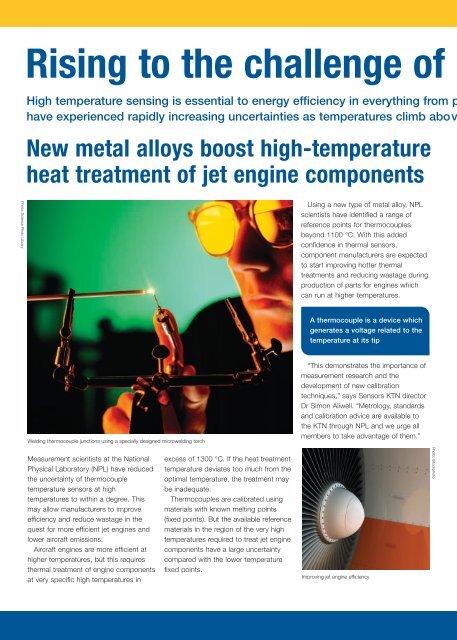Sensors News - Materials Science Institute of Madrid
Sensors News - Materials Science Institute of Madrid
Sensors News - Materials Science Institute of Madrid
You also want an ePaper? Increase the reach of your titles
YUMPU automatically turns print PDFs into web optimized ePapers that Google loves.
Rising to the challenge <strong>of</strong> h<br />
High temperature sensing is essential to energy efficiency in everything from p<br />
have experienced rapidly increasing uncertainties as temperatures climb abov<br />
New metal alloys boost high-temperature<br />
heat treatment <strong>of</strong> jet engine components<br />
Photo: <strong>Science</strong> Photo Library<br />
Using a new type <strong>of</strong> metal alloy, NPL<br />
scientists have identified a range <strong>of</strong><br />
reference points for thermocouples<br />
beyond 1100 °C. With this added<br />
confidence in thermal sensors,<br />
component manufacturers are expected<br />
to start improving hotter thermal<br />
treatments and reducing wastage during<br />
production <strong>of</strong> parts for engines which<br />
can run at higher temperatures.<br />
A thermocouple is a device which<br />
generates a voltage related to the<br />
temperature at its tip<br />
Welding thermocouple junctions using a specially designed microwelding torch<br />
“This demonstrates the importance <strong>of</strong><br />
measurement research and the<br />
development <strong>of</strong> new calibration<br />
techniques,” says <strong>Sensors</strong> KTN director<br />
Dr Simon Aliwell. “Metrology, standards<br />
and calibration advice are available to<br />
the KTN through NPL and we urge all<br />
members to take advantage <strong>of</strong> them.”<br />
Measurement scientists at the National<br />
Physical Laboratory (NPL) have reduced<br />
the uncertainty <strong>of</strong> thermocouple<br />
temperature sensors at high<br />
temperatures to within a degree. This<br />
may allow manufacturers to improve<br />
efficiency and reduce wastage in the<br />
quest for more efficient jet engines and<br />
lower aircraft emissions.<br />
Aircraft engines are more efficient at<br />
higher temperatures, but this requires<br />
thermal treatment <strong>of</strong> engine components<br />
at very specific high temperatures in<br />
excess <strong>of</strong> 1300 °C. If the heat treatment<br />
temperature deviates too much from the<br />
optimal temperature, the treatment may<br />
be inadequate.<br />
Thermocouples are calibrated using<br />
materials with known melting points<br />
(fixed points). But the available reference<br />
materials in the region <strong>of</strong> the very high<br />
temperatures required to treat jet engine<br />
components have a large uncertainty<br />
compared with the lower temperature<br />
fixed points.<br />
Improving jet engine efficiency<br />
Photo: iStockphoto
















